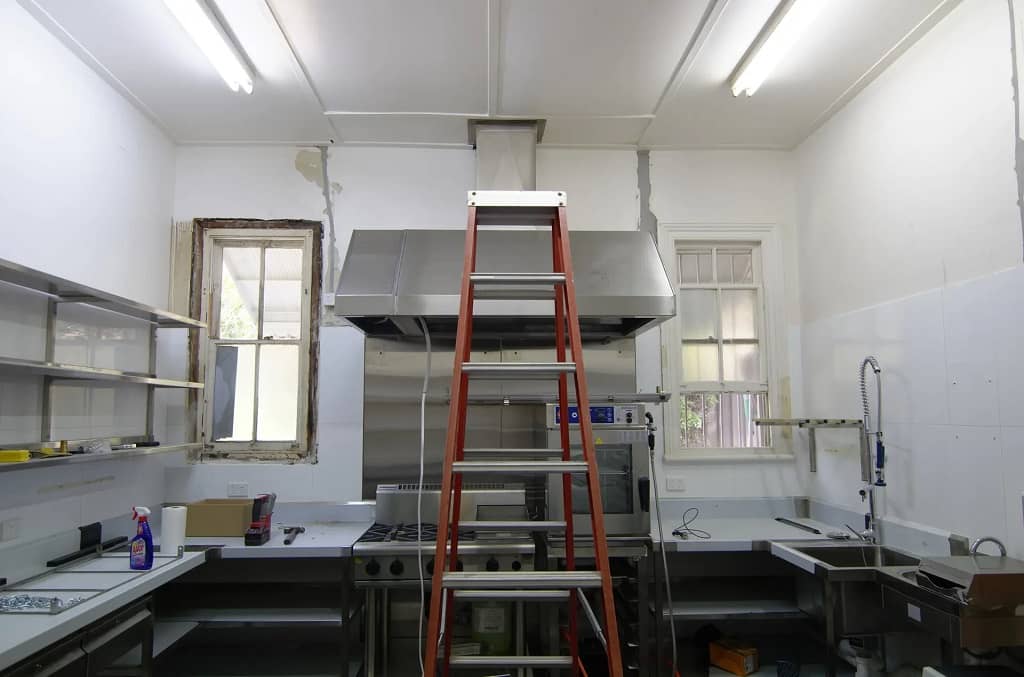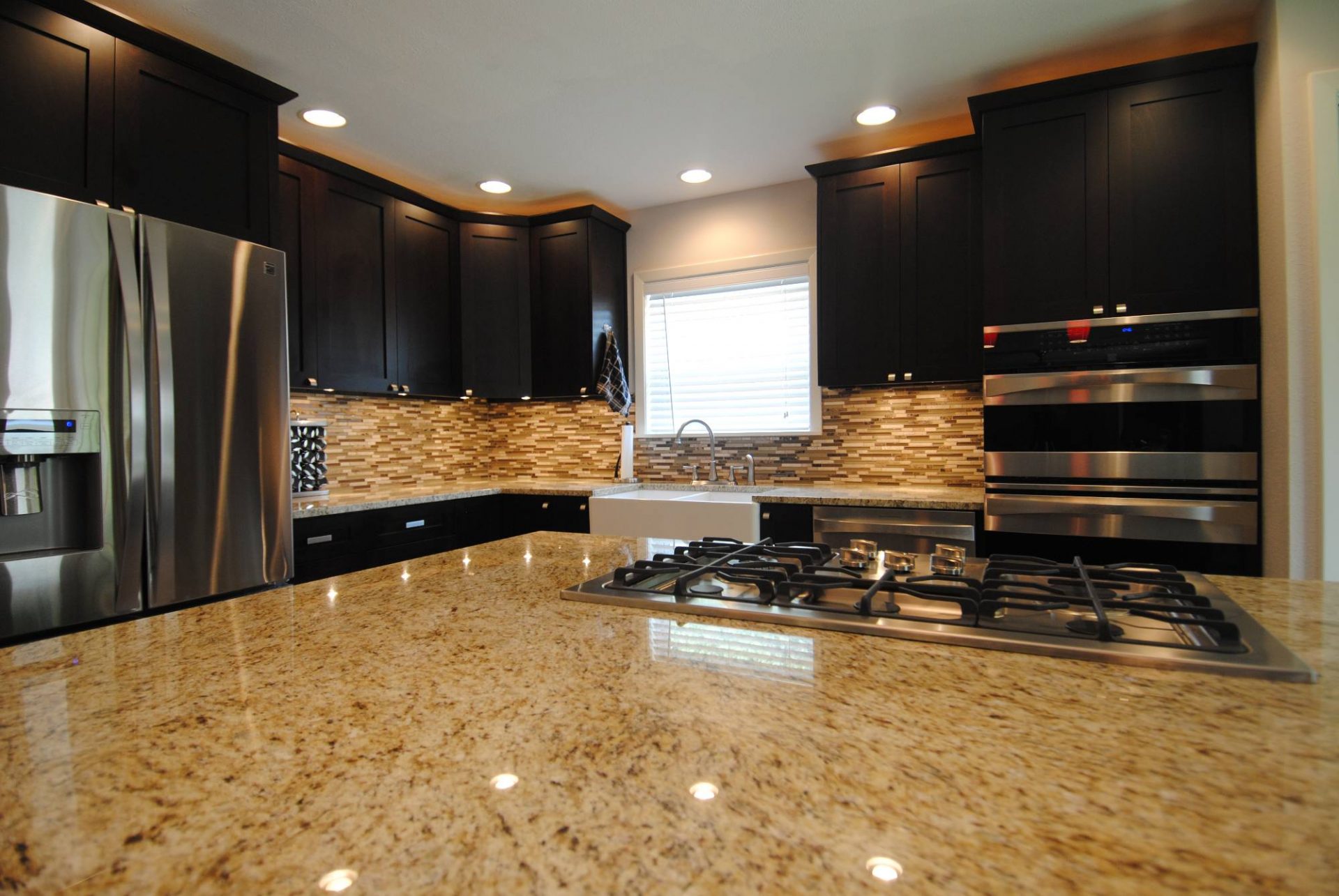The Naked Truth About the Kitchen Remodel Experience
Ahh, the joys of celebrating in your shiny, new kitchen. The spectacular granite-topped island beckoning your friends and family to gather sharing the love with a good cabernet in hand. Your kitchen is now a warm, well-lit oasis of comfort and pleasure, the new beating heart of your home…
Too bad you have to go through such pain and agony to get there. I’ve been remodeling kitchens for clients for over 35 years, and I’ve lived through the experience in my own home a couple of times. I’ll give you the straight dope on kitchen remodeling.

What You’ll Miss Most
If you wear a watch every day and you remove it to get it fixed, you suddenly realize how many times a day you unconsciously look at your wrist. Way more than you ever would have guessed, right? The same thing happens when you gut your kitchen to the studs.
First, you miss your kitchen sink. Who knew you were such a frequent visitor?
Rinsing produce before cooking, washing utensils and plates, washing hands, filling up pots for boiling noodles…Instead you might be washing dishes in the bathtub, and rinsing produce with bottled water. But really, using plasticware will become second nature.
Pretty much the only cooking inside you can do is in that microwave on the TV tray.
You don’t remember it being so small. Start your “restaurant list” now, because you’ll exhaust all your favorite spots in no time and quickly need some variety.
Even in the midst of a Texas summer, you’ll be grateful to have a grill in the backyard that lets you eat a meal at home. If you don’t own a crockpot, you might want to invest in one.
It takes at least two weeks to get used to finding the refrigerator in its odd new location in the den. As for the coffeemaker, it will never end up anywhere convenient.
There Are Plenty of Horror Stories

Responsible contractors “house train” their workers (even if they are subcontractors) for proper behavior.
My company has a written code of conduct that every crew must sign and follow.
For example, our guys are not allowed to smoke on the job, or talk politics or religion with our clients. And no urinating behind the garage, either.
Sadly, many contractors are not so house-trained. With a bad (cheap guy) contractor, you’ll have weeks of stalled progress, followed by having to fire that guy and hire a more expensive pro to tear out the substandard work and start all over; a high-stress nightmare.
And that’s just your run-of-the-mill bad contractor.
Here are some of the disaster tales my clients have recounted of their kitchen remodeling nightmares:
- “I came home and found a brick man stirring up mortar in a five-gallon bucket using my grandmother’s heirloom silver serving spoon.”
- “The drywall crew scheduled to be on site for two weeks polished off every prescription drug and bottle of alcohol we had in the house over the first three days.”
- “While I was out shopping, they raided my fridge and bar, then one fell asleep under my pool table and another on the master bed.”
- “They pulled all the furniture, my mattresses, and even my towels out into the back yard…and left them there for weeks. They were all ruined in the rain.”
Obviously these sins go way beyond playing loud radios and using foul language on the job!
Fortunately, there are some time-tested steps you can take to avoid these horrific ordeals.
Remodeling your kitchen may not be a “pleasant” experience, but believe it or not, it can be done in a reasonable amount of time and reasonably on budget.
You can even be friends with your contractor at the end, and rehire him or her to do your bathroom next!
Yes, Kitchen Redos Are Expensive
Whether you’re doing a “partial” remodel, a mid-range “gut to the walls” job, or a kitchen expansion into other rooms, it’s going to cost more than you want.
According to Remodeling Magazine’s Cost vs. Value 2021 Survey, a major mid-range kitchen remodel costs a national average of $75,571, while an “upscale” kitchen remodel will set you back an average of $149,079.
I generally concur with those numbers based on my own company’s experience.
Of course, you can spend less with good planning, but the naked truth is most people don’t realize what kitchen renovation work really costs, especially when using a good contractor with a high-quality construction team.
Why Are Kitchen Remodels Expensive?
From a construction standpoint, kitchens are one of the most complex projects to plan and execute.
They involve the most expensive elements in a home: new custom cabinetry, stone counters, tile on floors and backsplashes, plumbing, expensive appliances and fixtures, to name a few. Throw in wall removal to create that coveted “open look,” relocating the kitchen sink, raising ceilings, and expanding the footprint, and the price soars.
Don’t blame your contractor for running up the cost of the job or finishing late when you kept upgrading to prettier things along the way.
Remember that changes to the project add cost, interrupt the rhythmic schedule of a job, and extend the completion time.
You also shouldn’t expect to recoup these costs through increased home value.
At best, a minor mid-range kitchen remodel may return value up to 80%, but your typical major renos return roughly 50-60% on investment. For example, Remodeling Magazine’s latest numbers peg a major mid-range kitchen remodel’s ROI at 57.4%.
You May Experience Delays – A Kitchen Remodel Takes Longer Than You Expect
Here is the process a kitchen remodel follows, along with each step’s approximate length (when done by professionals):
- Tear-out and demolition: Ripping out walls, cabinetry, flooring, fixtures, etc. 1-3 days
- Rough-in work: Can range from moving framing in the walls around a new center island to moving plumbing fixtures or electrical outlets several feet. 2-5 weeks
- Professional inspection: Having the work certified for safety by a local city or county inspector. 1 day (plus any time spent waiting for your appointment)
- Finish the walls: Includes putting up drywall and priming. 1-2 weeks
- Install doors and windows (if desired): Includes sealing/insulation and trim work, inside and outside. 1-2 days
- Install cabinets and plumbing fixtures: Includes new countertops, sink, faucet, and garbage disposal. If countertops have to be specially fabricated, that will add to the time. 3 days – 3 weeks
- Bring in new appliances: Includes everything from the basics–microwave, stove, refrigerator–to luxury items, such as a wine chiller or water filtration system. 1-3 days
- Install new flooring: We prefer to do this at the end of a kitchen remodel to ensure none of the new floor is damaged while bringing in heavy appliances, dropping tools, etc. Time requirements vary slightly by material; for example, wood takes longer than ceramic tile. 3-6 days
Learn more about the steps involved in a kitchen remodel.
Delays and setbacks will obviously stretch out your timeline, and those are more likely to happen for DIYers, although some problems are nobody’s fault (except maybe the builder!).
For example, excessive use of cement may have made tile inseparable from the wall, but you won’t know that until you start trying to pry them off and they want to take the wall with them.
Or you may discover you have mold, or termites, or foundation problems during the demolition.
Supply chain issues for your countertops, flooring, or cabinets can hold things up, as well, as they have in 2021 for many home projects. This is why I always say, it takes longer than you expect. It’s just the nature of the beast.
Five Top Tips for Success On a DIY Kitchen Project
- If this is your first time taking on this kind of remodel, hire a good contractor and pay him $500 to consult with you for a couple of hours. Take notes. This could be the best money you spend on the project. Have him/her walk you through proper order of events, tell you what tools you will need, pitfalls to watch out for, where to find and when to use licensed trades (plumbers and A/C mechanics, etc.), and which walls may be load-bearing. Be sure you learn what things not to do yourself. Even better, pay the contractor $2,000-$2,500 for a “Professional Services Agreement” to help you develop your ideas into real, written Specifications you can build from. Once you have the whole thing professionally organized on paper, I guarantee you construction will go faster and smoother.
- Make a list of the destruction/construction steps you plan to take. What are you tearing out? appliances? countertops only? cabinets too? Write it all down first. Pros call this description “Specifications.” Specifications become your road map as work progresses.
- For steps of work you won’t be doing yourself, go to the stores where those guys buy their materials. For example, you could go to a good plumbing showroom and get the names of a couple of plumbers they know well, and know to be reputable. A good lumberyard may point you to a good trim carpenter or framer they’ve seen across the counter for years. Understand that your project is a one-time deal so it may be lower priority scheduling-wise. These guys have regular builders who keep them busy and write them checks every week for years. You can’t compete with the depth of that lucrative relationship, so be patient.
- Don’t buy anything until you make a complete “selections list” – a list of all the plumbing fixtures and appliances. Remodeling is no different than grocery shopping: if you go with no list, feeling hungry, you’ll buy goofy stuff and regret it later. Pick out your countertop, backsplash, and floor tile together. They are large, important surfaces that need to “match.”
- If you’re doing all new cabinets, get someone to design details for you, even if you plan to build them yourself. Stay away from cabinets with any particle board in the boxes. This means avoiding most “off the rack” cabinets at the box stores and also those plastic-covered Danish ones. I won’t mention any names.
For more help, check out our list of nine mistakes to avoid during a DIY kitchen renovation.
Five Top Tips for Success When Working with a Professional Remodeler
- Do your internet homework. Good contractors have lots of good reviews on Google, Houzz, Angie’s List, etc. If you’re having trouble finding any reviews for a candidate, pass him by. That’s a huge red flag.
- Put the company name in the Better Business Bureau website search box. If they’re reputable they will show up with a score like A+, B+, and so on, and will be “accredited.” If they’re not listed or at least accredited, run. That’s another huge red flag! Having no website is a deal-breaker, as is a terrible one or a two-page website, or a website that looks like it hasn’t been updated in years.
- Call your local Builders Association. They will have a list of reputable remodelers and builders and can usually tell you whether they work in your part of town. In states such as Texas that have no contractor licensing, you have to be particularly careful. In any state, limit your candidates to those that have one or more construction certifications from the National Association of Homebuilders, such as “Certified Graduate Remodeler,” “Certified Aging in Place Specialist,” “Graduate Master Builder,” and the like. Any contractor who belongs to a trade association and has certifications subscribes to a code of ethics and is going to be a very good bet for success.
- Do a good phone interview before inviting the remodeler out. Find out if he mainly works in your part of town. How long has he been in business? Is kitchen remodeling a mainstay project for him or an occasional sideline? Will he let you come see a kitchen remodel in progress?
- Get, and call references. Ask them what the experience was like having that crew in the house. What were the workmen like? Was there always an English-speaker on site? How neat was the house kept during the work? Did you get a weekly schedule? How well was the day-to-day communication and job management done? Could you get someone on the phone quickly if there was a problem? Did you feel you got a good value for the money you paid? These are excellent questions to check out a contractor before anyone comes out to look at the job.
I have an 11-question “Contractor Test” that you can read over the phone, at this link: https://legaleaglecontractors.com/contractor-test/. You are welcome to print off and use this test to find and screen contractors.
Kitchen Remodels – A Disruptive But Rewarding Experience

So there you have it, the naked truth about kitchen remodeling.
It can be a nightmare or it can just be difficult and disruptive, but well worth it.
Like most things in life, you get what you pay for.
If you hire “Joe Pickup” the price will be cheap but the cost on your brain and body will be high.
Use the tools and advice above to find the right contractors and create that spectacular kitchen. Remember, remodeling is like child-birth: the pain will soon fade and you’ll enjoy your beautiful new baby for years to come.
© By Dan Bawden, updated July 2021






